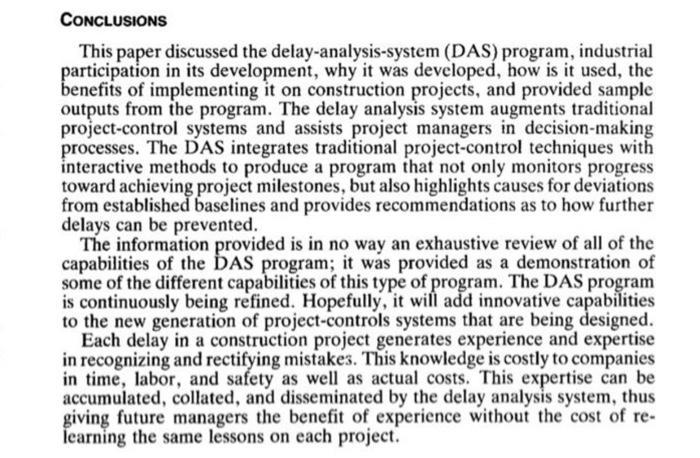Answered step by step
Verified Expert Solution
Question
1 Approved Answer
One major advantage of the delay analysis system is the consistency introduced into decision-making processes. An interactive system that fully integrates the data-collection system


![INTRODUCTION The Construction Decision Support System for Delay Analysis (delay analysis system (DAS)] augments existing proj](https://dsd5zvtm8ll6.cloudfront.net/si.experts.images/questions/2021/09/6149d92ce896b_1632229675820.jpg)
One major advantage of the delay analysis system is the consistency introduced into decision-making processes. An interactive system that fully integrates the data-collection system of a project eliminates the requirement of handling the same data numerous times, which is important considering . the vast amount of data generated by scheduling and control systems. Another advantage of the delay analysis system is that it reduces the amount of time required to gather data for the dispute-resolution process upon completion of a construction project. The long process of apportioning equitable allocation of responsibility for delays would be reduced by the availability of computer data bases and the documentation provided by the delay-analysis program. Each time an activity is processed, the information is stored in a historical data base. The information can be retrieved either by date or activity code. The program helps document decision-making processes. and a traceable link between collected project data and decisions is formed. Using the delay analysis system also allows managers to review decisions made under similar circumstances, which helps them to make more-informed decisions. It also furnishes managers with the proper tools for providing clients. top man- agement, and construction personnel with accurate project-progress infor- mation. As the delay analysis system is further developed the gathering and dis- 242 J. Constr. Eng. Manage., 1993, 119(2): 226-244 pensing of information will be streamlined, roles of planning and policy- making will be modified, levels of uncertainty will be adjusted, and the overall philosophy of project management can be reexamined. Project- management systems should be designed to be flexible to accommodate the uniqueness of each project, its location, and its control management style; the DAS program demonstrates the importance of integrating computer systems with management methodologies. CONCLUSIONS This paper discussed the delay-analysis-system (DAS) program, industrial participation in its development, why it was developed, how is it used, the benefits of implementing it on construction projects, and provided sample outputs from the program. The delay analysis system augments traditional project-control systems and assists project managers in decision-making processes. The DAS integrates traditional project-control techniques with interactive methods to produce a program that not only monitors progress toward achieving project milestones, but also highlights causes for deviations from established baselines and provides recommendations as to how further delays can be prevented. The information provided is in no way an exhaustive review of all of the capabilities of the DAS program; it was provided as a demonstration of some of the different capabilities of this type of program. The DAS program is continuously being refined. Hopefully, it will add innovative capabilities to the new generation of project-controls systems that are being designed. Each delay in a construction project generates experience and expertise in recognizing and rectifying mistakes. This knowledge is costly to companies in time, labor, and safety as well as actual costs. This expertise can be accumulated, collated, and disseminated by the delay analysis system, thus giving future managers the benefit of experience without the cost of re- learning the same lessons on each project. INTRODUCTION The Construction Decision Support System for Delay Analysis [delay analysis system (DAS)] augments existing project-control software packages by adding the capability for determining possible causes for project delays and suggesting alternative courses of action to prevent further delays. The delay analysis system program integrates expert knowledge with existing control systems in order to streamline construction-delay analysis and de- cision-making processes. The purpose of the DAS system is to provide an auxiliary computer software program that processes information related to project delays (both current and historical). The delay analysis system computer software program simulates the pro- cess of delay determinations by comparing technical parameters and ac- cessing knowledge bases. Potential causes of delays are determined and the program generates suggestions for possible alternative courses of corrective actions to reduce delays. The delay analysis system is not merely another scheduling software. It provides information related to the causes of project delays that is not available in project-control software packages, and it is used to augment existing scheduling software packages. In addition to each element of a project being monitored by project- management personnel, adequate feedback must also be provided to allow the selection of corrective actions in order to reduce or eliminate delays. The DAS program does not neglect human factors and judgments (which are required as an essential part of the analysis process); therefore, the program does not make decisions, but merely presents information required by managers to make more effective decisions, and it bases this information on the expert knowledge contained in the data bases.
Step by Step Solution
★★★★★
3.36 Rating (159 Votes )
There are 3 Steps involved in it
Step: 1
ANALYSIS The famous processbased methods include the global impact net impact adjusted asbuilt CPM asplanned expanded butfor snapshot time impact windows and isolated delay type techniques Mathematica...
Get Instant Access to Expert-Tailored Solutions
See step-by-step solutions with expert insights and AI powered tools for academic success
Step: 2

Step: 3

Ace Your Homework with AI
Get the answers you need in no time with our AI-driven, step-by-step assistance
Get Started


